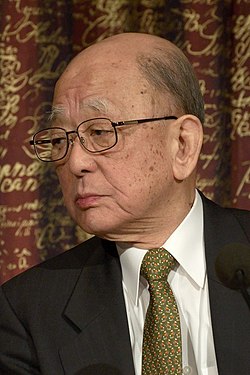Search results
Appearance
There is a page named "Ei-ichi Negishi" on Wikipedia
- Ei-ichi Negishi (根岸 英一, Negishi Eiichi, July 14, 1935 – June 6, 2021) was a Japanese chemist who was best known for his discovery of the Negishi coupling...21 KB (1,850 words) - 03:41, 3 April 2025
- after Ei-ichi Negishi who was a co-recipient of the 2010 Nobel Prize in Chemistry for the discovery and development of this reaction. Negishi and coworkers...35 KB (4,081 words) - 23:32, 13 March 2025
- awarded the Nobel Prize for Chemistry together with Richard F. Heck and Ei-ichi Negishi. To celebrate International Year of Chemistry (IYC 2011), Suzuki was...11 KB (948 words) - 02:09, 19 March 2025
- the 2010 Nobel Prize in Chemistry, shared with the Japanese chemists Ei-ichi Negishi and Akira Suzuki. Heck was born in Springfield, Massachusetts, in 1931...17 KB (1,590 words) - 05:53, 30 March 2025
- recognized by the 2010 Nobel Prize in Chemistry to Richard F. Heck, Ei-ichi Negishi, and Akira Suzuki. Such reactions are widely practiced for the synthesis...63 KB (6,681 words) - 19:33, 20 March 2025
- shared the 2010 Nobel Prize in Chemistry with Richard F. Heck and Ei-ichi Negishi for their contribution to the discovery and development of noble metal...35 KB (3,965 words) - 11:28, 7 February 2025
- 2010, the Nobel Prize in Chemistry was awarded to Richard F. Heck, Ei-ichi Negishi and Akira Suzuki for their work on palladium-catalyzed cross-coupling...4 KB (251 words) - 19:35, 22 June 2024
- Yamanaka, Physiology or Medicine, 2012 Akira Suzuki, Chemistry, 2010 Ei-ichi Negishi, Born in China, Chemistry, 2010 Osamu Shimomura, Chemistry, 2008 Toshihide...79 KB (8,131 words) - 11:27, 28 March 2025
- Negishi (根岸) is a Japanese surname and place name. It may refer to: Ei-ichi Negishi, a Japanese chemist who was awarded the 2010 Nobel Prize in Chemistry...1 KB (176 words) - 20:11, 14 November 2021
- Syracuse University (BS, 1981), Purdue University (PhD, 1986 under Ei-ichi Negishi) and completed postdoctoral work at the University of Wisconsin–Madison...28 KB (2,545 words) - 12:18, 30 March 2025
- Yoshinori Ohsumi Kenzo Tange Yoichiro Nambu Kiyoshi Ito Teiji Takagi Ei-ichi Negishi Nine Nobel-awarded scientists have earned degrees from UTokyo: six...145 KB (12,236 words) - 10:12, 29 March 2025
- Ei-ichi)hockey player Eiichi Nakao (中尾 栄一, born 1930), Japanese politician Ei-ichi Negishi (根岸 英一, born 1935), Japanese chemist Eiichi Ohtaki (大瀧 詠一, born 1948–2013)...3 KB (284 words) - 14:10, 10 March 2025
- was awarded the 2010 Nobel Prize in Chemistry, which he shared with Ei-ichi Negishi and Akira Suzuki, for the discovery and development of this reaction...13 KB (1,355 words) - 19:29, 15 December 2023
- coupling reaction is the cross coupling reaction. Richard F. Heck, Ei-ichi Negishi, and Akira Suzuki were awarded the 2010 Nobel Prize in Chemistry for...7 KB (448 words) - 08:46, 27 March 2025
- was highlighted by the award of the 2010 Nobel Prize in Chemistry to Ei-ichi Negishi. Rieke zinc, a highly reactive form of zinc metal, is generated by...40 KB (4,097 words) - 14:20, 11 February 2025
- Cross-coupling reaction are a subset of coupling reactions. Richard F. Heck, Ei-ichi Negishi, and Akira Suzuki were awarded the 2010 Nobel Prize in Chemistry for...17 KB (1,499 words) - 14:59, 24 February 2025
- Technology unit. Two faculty members (chemists Herbert C. Brown and Ei-ichi Negishi) have been awarded Nobel Prizes while at Purdue. In all, 13 Nobel Prizes...116 KB (10,205 words) - 02:32, 3 April 2025
- Thomas A. Steitz / Ada E. Yonath 2010: Richard F. Heck / Akira Suzuki / Ei-ichi Negishi 2011: Dan Shechtman 2012: Robert Lefkowitz / Brian Kobilka 2013: Martin...67 KB (7,298 words) - 20:18, 13 March 2025
- won the Nobel Prize for Chemistry jointly with Richard F. Heck and Ei-ichi Negishi. Benjamin List, winner of the 2021 Nobel Prize in Chemistry, is the...26 KB (2,686 words) - 14:57, 7 March 2025
- Ei-ichi Negishi (2002). "II.2.3 Pd(0) and Pd(II) Complexes Containing Phosphorus and Other Group 15 Atom Ligands" (Google Books excerpt). In Ei-ichi Negishi...3 KB (208 words) - 19:01, 4 February 2025











